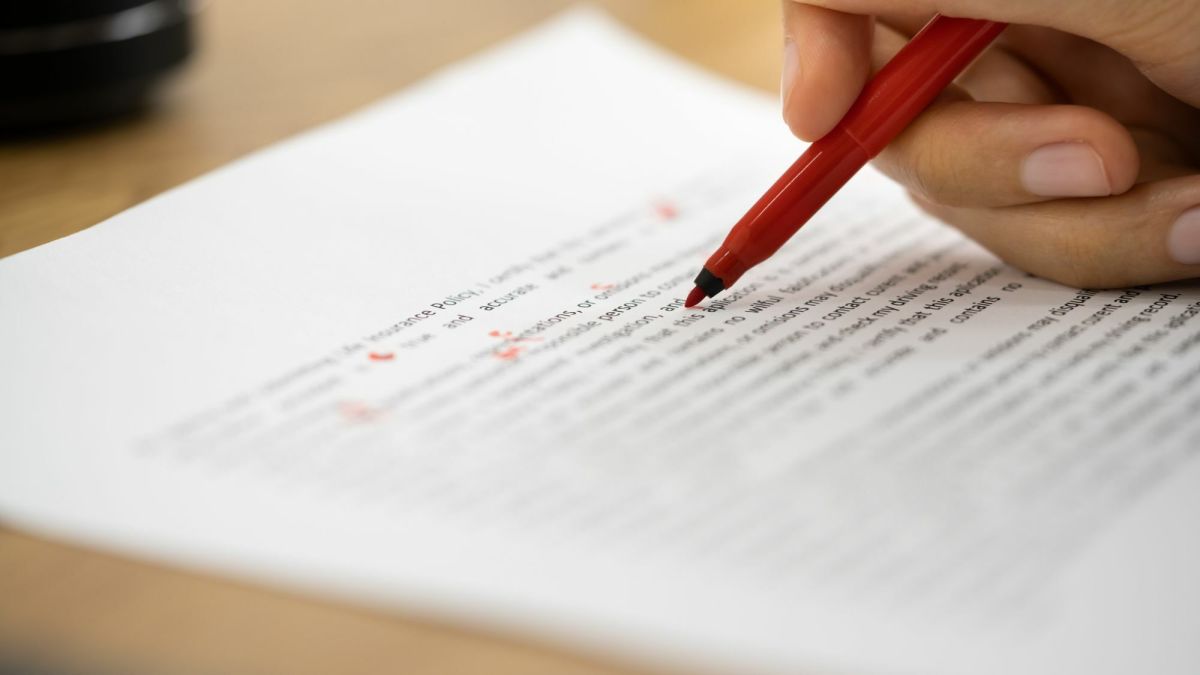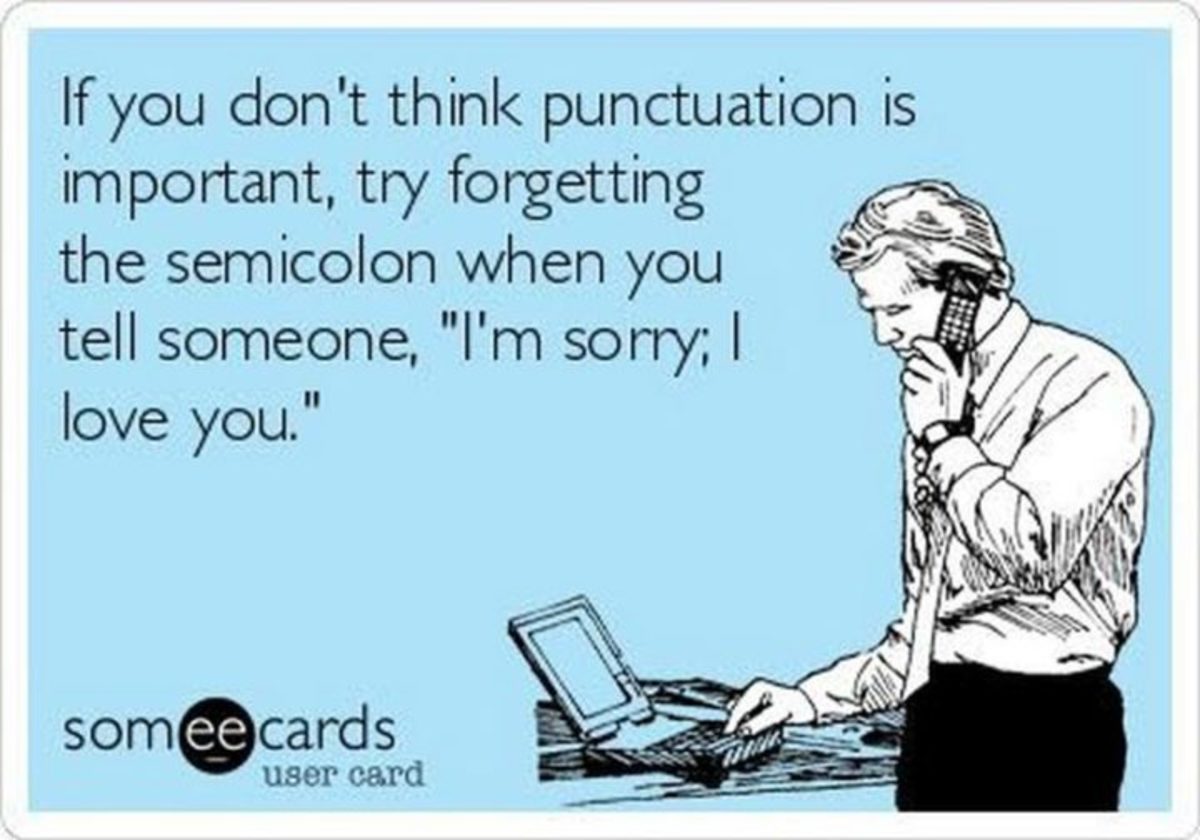How to Proofread and Edit Essays

How to Improve Your Essay Scores
The most difficult part of essay writing is actually getting the darn thing written and ready to go. The "getting it written" part is especially toilsome because of all the time you spend thinking of how to say something just right, as well as the part where you have to go and research your topic. This time consuming process is what makes the whole "ready to go" part so tiresome since you feel like you are just ready to be done with it and go to sleep, rather than look for any errors, now that it's about 3:00 AM and it's due in five hours.
The "ready to go part" I am talking about is the part where you actually proofread and edit your essay. Learning how to do this properly is all good and dandy but making sure you understand just why you need to make that last push is key as well. Why bother scanning through it once or twice more when you already have something to turn in?
Well, to those who may ask that question, I say that if you want your essay scores to go up, proofreading and editing them before you hand them in to your teacher is a surefire way to get there. You'd be surprised just how many spelling, punctuation, and grammatical errors you make without realizing it until you take that second look. When you turn in something that hasn't been proofread or edited, your teacher will notice and they will not be happy. When a paper is full of errors, it makes it look like its author is lazy and is not taking the topic, teacher, or class as seriously as they probably should.
If you aren't quite sure how to proofread and edit properly, take a look at my easy steps below. Just remember to give yourself plenty of time for this step before you get to writing. I know students tend to do things last minute but make sure that this part is squeezed into that last minute urgent writing session the night before the essay's due date (even though it is always much better to give yourself much more time to write a proper essay if you really want the best grade possible).


Do you proofread and edit?
Do you proofread and edit your essays?
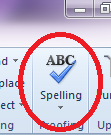

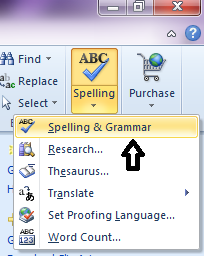
Using Word to Edit and Proofread
While writing your essay, pay attention to any of the notifications for spelling or and other errors that automatically comes up with the program you are using. If you are using Microsoft Word, for example, spelling errors will show up as a squiggly red line underneath the word that is misspelled, while grammatical errors are underlined with a green squiggly line.
Rather than scanning through the entire essay, one easy way to check for these errors can be found under the Home menu. Click Home, and then go to the symbol that says "ABC" with a check mark under it. These can be found at the top of your page, as is shown in the picture above. You can click this symbol or select where it says "Spelling" with a small arrow underneath it. A drop menu will appear and you want to select "Spelling & Grammar." Both of these are shown in the pictures to the right.
Using this tool makes it easy to proofread and edit your essay using what right there in the program because you can go through everything that the program recognizes as an error with just a few clicks. It will not only point out these mistakes, but it will also explain why they were highlighted if you click the "Explain..." button on the right hand side of the "Suggestions" box that lists your errors.
Keep in mind that the program isn't always right so try and use what knowledge you have about correct word choice or spelling. You may even want to check a dictionary if you feel like you know you spelled it correctly, despite what Word is trying to tell you. For example, you can see below where Word thinks I used the incorrect form of "it's" in a sentence from the first portion of this article. If I were to change the sentence to what the program is suggesting, I would be using the possessive form of the word, saying that "its due" rather than "it is due" in five hours.
I do not recommend depending solely on whatever program you are using to write your essay to proofread and edit your essay. I only suggest this as the first step so that you can find some of the easier to spot errors before you really get to reviewing your essay. if you're one of those people that just always ends up doing their essays last minute, this is one way to do the bare minimum for proofreading and editing your essay before you turn it in.
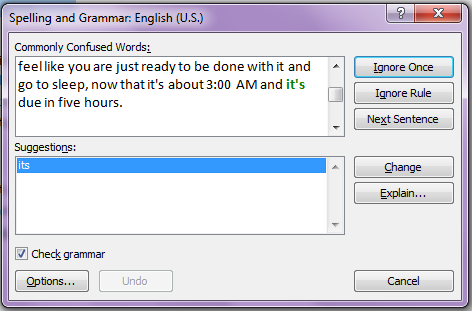


Editing Tip: Read Aloud
Reading out loud to yourself may make you feel a little strange at first but you'd be surprised how many errors you find. If it doesn't read smoothly, chances are, there's something wrong with that sentence or paragraph that just got you tongue-tied.

How to Write a Quality Topic Sentence for an Essay
- How to Write a Quality Topic Sentence for an Essay
Sometimes the most difficult part of writing is just getting started. Here are tips on how to write a successful topic sentence for your essay, which is almost as important as your thesis.
Proofreading Essays for Editing
Now that you have gone through any of the errors that the program has found in your writing, you want to read the paper yourself. At this point, I recommend that, if you have the time for it, you go and take a break. Sometimes walking away from an essay and then coming back to it makes it easier to see it with a fresh perspective and catch things you may have otherwise skipped over before. Your break can be an hour long or you can leave it for a day or two, if you have given yourself that much time to work on it before it's due.
When you go through your essay to proofread and edit this next time, I also recommend you print it out. When you read text on a computer screen, your eyes tend to get lazy, especially since you've already gone through this text at least twice or more at this point. Printing it off and having a hard copy to go over makes it easier to keep your eyes focused on the text so you can pay attention to every detail as you edit and proofread.
You want to go over this printed version of your essay two times. The first time, look for any spelling errors. The second time, look for anything else, such as grammatical or punctuation errors. Yes, it's not as easy as it would be if you just fixed everything automatically on the screen instead of having to go through and find where those errors on your paper are in its digital version but, believe me, all this work will pay off.
I also recommend handing off a hard copy or emailing a digital copy of your paper to a trusted friend. Your friend is even more likely to find errors you may have missed because they weren't the ones who wrote it and read it over and over. This is yet another fresh perspective to the paper that guarantees success, as long as you trust their proofreading and editing skills.

What common errors do you make?
What are the errors you usually make in your essays?
Common Errors in Essays
When trying to find errors in your essay while you proofread and edit, it is important to know what kinds of things to look for. According the University of Wisconsin, the twelve most common writing errors in essays are as follows:
- Sentence fragments
- Sentence sprawl
- Misplaced and dangling modifiers
- Faulty parallelism
- Unclear pronoun reference
- Incorrect pronoun case
- Omitted commas
- Superfluous commas
- Comma splices
- Apostrophe errors
- Words easily confused
- Misspellings
Since these are the most common errors, chances are, you have one or two of these in your essay somewhere. Try and look for these as you go through your proofreading and editing. If you don't know what some of these are, I have defined them for you here.

Sentence Fragments
Sentence fragments are basically sentences that cannot stand by themselves. They're missing that little thing called an independent clause that is just a fancy word for a group of related words put together with a noun and a verb. Why is this a big deal? Well, not only is it unable to stand alone, but it isn't even a complete thought.

Sentence Sprawl
When something is drawn out instead of put into more concise terms, it can be boring for the reader. When this happens it's known as a "sentence sprawl." The sentence may be correct grammatically as well as in its spelling and punctuation, but, the last thing you want to do is lose your reader's focus while they read.

More Info for Misplaced/Dangling Modifiers
- Misplaced and Dangling Modifiers
These definitions and examples of misplaced and dangling modifiers comes from the University of Ottawa.
Misplaced and Dangling Modifiers
Misplaced modifiers are put in places in the sentence where they modify the wrong thing. On the other hand, dangling modifiers are usually (but not always) at the beginning of the sentence and acts as a dependent clause or a phrase whose subject and verb are implied rather than expressed. Basically, it acts as an adjective for the rest of the sentence but fails in actually modifying any specific word or modifies the wrong word. I know it's confusing. For more information, check out the link to the right.

Faulty Parallelism
Faulty parallelism occurs when you do not tie in matching ideas within a sentence or items within a series. Just make sure that you are not putting two completely different ideas into one list or phrase. This makes it difficult to understand what you are saying and, at times, confuses the reader.

Unclear Pronoun Reference
Make sure that all of your pronouns clearly refer to specific nouns. Paying careful attention to how you use it, they, this, that, these, those, and which can help avoid any confusion for your audience.

Incorrect Pronoun Case
Keep in mind whether the pronoun in each sentence is being used as a subject, object, or possessive and use the correct pronoun form to match. For example, saying "there was a conflict between he and the world" is incorrect. The correct version would be "there was a conflict between him and the world."

Omitted Commas
Don't be afraid to use commas within your sentences. Commas are used to signal nonessential material, prevent confusion, and to indicate relationships between ideas and sentence parts. I used to have problems deciding where to use and them but one teacher explained that if you read a sentence and have to take a breath or pause, then you probably need a comma (or a period).

Superfluous commas
Of course, the other side of this spectrum are those who use too many commas. I fell into this category when I tried making up for all the commas I'd left out of my writing before. Unnecessary commas make sentences difficult to read. Again, reading out loud may help. Just remember to take a breath or pause at each comma. If it doesn't make sense to do so, chances are, you don't need it there.

Comma Splices
Yet another common mistake is taking two independent clauses and trying to put them together with a comma. Instead of a comma, using conjunctions such as and, or, but, for, nor, so, or yet will help to tie them together in a smoother fashion that the reader can easily comprehend. When in doubt, just rewrite the sentence or use a period to separate the two ideas into two different sentences.

How to Use the Possessive Apostrophe
- How to Use the Possessive Apostrophe
Apostrophes can get pretty complicated and you can use them incorrectly if you aren't careful. Find out about the possessive apostrophe and just when you're supposed to use those darn things.
Apostrophe Errors
Believe it or not, I have had many an argument with friends and fellow students about the correct use of apostrophes. In some cases, they're an easy fix, while others make me pull out my Chicago Manual of Style and try to figure out just what I'm supposed to do. Just remember when apostrophes are used to indicate possession and when they make up a contraction (think of "its" versus "it's").
For more help on apostrophes, check out my article on possessive apostrophes to the right.

Words Easily Confused
Some of the most commonly misused words are as follows:
- "Effect" and "Affect" (effect is usually a noun while affect is almost always a verb)
- "Lead" and "Led"
- "Accept" and "Except"
- "Woman" and "Women"
If you are ever confused, ask a friend or look up the word in a glossary for the correct usage.

Misspellings
Misspellings happen to the best of us but when they're frequent enough, your reader may just see it as carelessness. This is why proofreading and editing your essay is essential if you want a good grade. Arguably the easiest kind of error you can look for is misspellings so don't let this common mistake get in between you an that A grade on your next essay.

© 2012 Lisa







